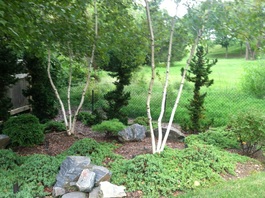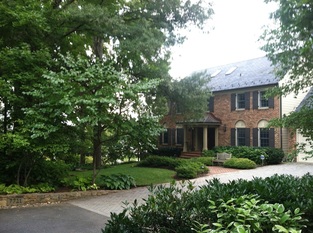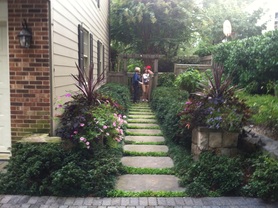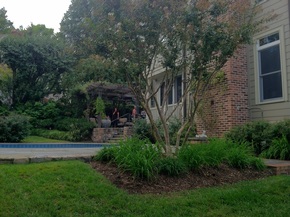|
Submitted by Dawn Szelc, LDG Secretary Kudos to the Landscape Designer’s Group Program Committee for the most recent meeting. We were treated to an after-hours tour of the Mount Vernon grounds and gardens with the Director of Horticulture, Dean Norton. Dean has worked at Mount Vernon for 45 years and is a wealth of knowledge about the history, workings, and horticulture of Mount Vernon. We met Dean in front of the Mount Vernon Inn and drove through the property in a large van with a couple additional vehicles trailing behind. Right near the Inn was the main visitor entrance which is a large gate called the Texas Gate. The gate was installed in 1899 with donations from Texas school children. Where the gate is located now was the end of the trolley line, and the original station is now part of the Mount Vernon Inn. It was popular for people to travel there on the trolley to buy eggs and fresh produce which were sold in the area. We then passed the original firehouse. Mount Vernon had been visited by Henry Ford in 1923, and he was impressed with the property except he felt that they did not have appropriate fire suppression. He supplied a fire engine which was upgraded in 1936 and was used for many years even up until the point that Dean started working there – 1969. Our first stop was at the West Gate which was the original entrance. From the gate you have a view to the mansion house which is a mile away. The drive to the house was not direct but wove into the forest and out to clearings showing glimpses of the house as visitors approached. Dean described how Washington wanted to only use living hedges, grown from hawthorn, blackberry, and other prickly shrubs, to separate areas or keep out livestock. He would also use fallen timbers but did not wish to cut live trees. The current forest is 100-120 years old, so not from Washington’s time. From numerous large storms trees have been lost – many in the 1920s. They are currently battling the deer who eat all the new saplings or acorns and so there is little regeneration of the forest. Dean also stated that many of the fields which Washington used were also protected by ditches which were dug by his slaves. Dean then drove us towards the mansion while explaining where the original road was believed to have been. We eventually ended up in front of the circular drive to the mansion. Here he also talked about the bees that are kept on the property. Last winter all the bees were lost, due to the weather and not Colony Collapse, so they work to get their Queens from local suppliers with the idea that they will do better overall in keeping the hive alive due to any circumstances. Our next stop was the Pioneer Farmer site with the octagonal barn - left photo below. This is a recreation of the barn designed by Washington. There was one picture of his original building which shows that the original design was a 16 sided barn - right photo below. Washington used a seven year crop rotation system growing wheat, corn, rye, as well as keeping sheep. He started with tobacco, but that crop was tied to England’s system for payment so he ended up in debt. As he transitioned to wheat he needed the barn for threshing and also had his own grist mill which was fully automated. He sold much of the wheat to the West Indies for cash. The wheat was laid in a specific pattern in the barn, and the horses walked around and helped to winnow the grains from the hay and chaff. The grains fell through the slats in the floor to the lower floor. This was his own design. Washington would experiment with new farming techniques to try to improve sustainability. He and Jefferson were wealthy enough to risk the expense and shared information. The results were handed off to other farmers. One of his experiments was to find a mix of compost which was the best for crop growth. He tried out a number of different types to discover what worked the best. Near the barn is an example slave cabin which Dean described as better than most southern slaves had. There was a small garden as most had to grow additional food to sustain themselves beyond some basic supplies which Washington provided, such as a small amount of salt fish. We then got back into the van and drove up towards the kitchen garden, passing Washington’s tomb and the slave burial ground. We also passed some of the Ha-Ha walls that were used on the property. We parked in front of the circular drive and walked to the kitchen garden. Here there were expanses of vegetables and espaliered fruit trees – apples and pears in the center and stone fruits along the brick walls. These were done in four layers instead of the usual two and were managed by Martha Washington. At one end of the garden was the “necessity” which was built in 1760. The brick wall helped to create a micro-climate within the garden to be able to extend the growing period. They also employed cold frames to help as well. They had one full time gardener and were able to feed 14-18 people. Many visitors who were traveling through the area would stop and stay at Mount Vernon on their trip, so they ended up feeding many people throughout the year.
The grass there was mowed by scything it, throwing out worm castings and then raking. There was also a very large boxwood near where we were standing. This was from a plant originally sent to Washington by Henry “White Horse Harry” Lee. He sent him 12 plants and this one is all that is left. It has sustained itself via layering so all the branches seen from the outside are the layered add-ons. The interior is open and one can stand in the middle. When questioned about his responsibilities at Mount Vernon, Dean said “everything green” on the property. His main focus is looking for historical accuracy. He stated that Washington was not often in residence but did most of his landscape designing in 1785-1786. Washington thought that the best gardeners were Scottish because they were good in both social graces and gardening – an important distinction at that time.
2 Comments
 by Lynn Koch (edited by Holly Radus) What a wonderful event the LDG Potluck was! John and Ellie Shorb hosted us in their beautiful and spacious home, and delicious pizzas were cooked in their pizza oven in a room off the kitchen. There was lots of laughter and conversation, and it was great catching up with fellow LDG members. I would like to express my personal thanks to the LDG Board for all their hard work this past year in making it a stellar 2014 for our membership. The programs were fun and interesting, and as always, I learned so much. I want to pass along a special thanks to Mary Rollefson, who dived right in to handling the position of President with grace and enthusiasm, despite a busy personal and professional life. Thanks, Mary, and to all of you on the Board who volunteered your time this year. - Lynn Koch Photos by Alex McCarty
Submitted by Susanna Membrino and Dawn Szelc  The Landscape Designers Group met Thursday night, September 18 in Virginia to view two gardens designed by LDG members, and conveniently located side by side. The first garden on the tour in Alexandria on Northdown Road was designed by Lynne Church of Lynne Church Landscape Design and Mark Emmell of Greensmiths, Inc. Carved by backhoe from a jungle of honeysuckle and wisteria in 2009, the garden has been improved upon every year since. The owners, nostalgic for their Mt. Dessert summer home, asked for “a bit of Maine on the Potomac.” In response, Lynne chose plants that either grew in Maine or resembled ones that did. Stonework was constructed of large chunks of granite and boulders resembling those along the coast. Plants that invoked Maine included birches (Betula platyphylla var. japonica ‘Whitespire’), white pines, rugosa roses, smooth hydrangeas, ferns and several viburnums. In another corner, Mark built a raised stone terrace of thick granite blocks and ran a pondless waterfall along the side. Lynne used native plants wherever she could to surround the terrace and highlight the stream. Most of the garden is in shade and therefore subtle in its color. Caryopteris x clandonensis was in bloom and brightened an area next to the entrance of the driveway. Over time that area has taken on the feel of a beautiful woodland with spicebush and several varieties of viburnum. A sweetbay magnolia greets visitors at the foot of the steps leading up to the house. A sweep of oakleaf hydrangeas unifies the front of the house and creates some privacy from the street.  The second garden, designed by Joan Honeyman of Jordan Honeyman Landscape Architecture, was built all at once ten years ago. The job took most of a year, from design through two months of hardscape construction and a long week of planting several 7-8’ trees, countless shrubs and perennials. In the front, a low stone wall featuring a block of stone carved with the house number welcomes the visitor to enter via a generously open path to the front door. Again, the property is fairly shady and Joan makes use of a variety of hosta, azaleas, hydrangeas and ferns to define the space.  Along the side of the house lies a path to the rear garden. Large regular flagstone pavers interplanted with mazus lead to a cedar and metal gate designed by Joan through which one enters the more informal spaces of the back yard. Originally, the yard had a swimming pool and deck with a spring under the deck. Joan chose to create a multi-level garden by installing a large curved sweep of a deck to bring visitors out into the garden. Under a pergola as you enter you will find a terrace with a fire pit just off the rear of the house.
 Turning back towards the house, one passes by a raised stone wall and across seemingly random pavers set directly into the lawn. In both gardens the lots are constrained by slope, several mature trees, and partially wet conditions, and in both cases the designers capitalized on these potential drawbacks and created gardens of privacy, character, and adaptability. |
AuthorsLDG is a non-profit corporation dedicated to the exchange and enhancement of knowledge relevant to the landscape design profession. We are a group of professional designers in the metropolitan Washington, DC area. Membership is meant for students studying and professionals employed in landscape design or associated professions (i.e. arborists, installers, contractors, etc.). Archives
October 2023
CategoriesPast Newsletters can be found in the Members Only Section of the LDG Membership Connection. You must sign in to view these files.
Past Newsletters |
|
Search for a Landscape Designer in Your Area:
|














 RSS Feed
RSS Feed
